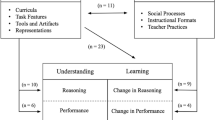Abstract
The use of Computer Algebra Systems (CAS) in years 9 and 10 classrooms as a tool to support learning or in preparation for senior secondary mathematics is controversial. This paper presents an analysis of the positive and negative aspects of using CAS identified in the literature related to these year levels, along with the perceptions of 12 experienced secondary teachers who were working with years 9 and 10 students. The literature review shows that CAS is valued for calculation and manipulation capabilities, the option of alternative representations, the opportunity for systematic exploration and for prompting rich discussion. However, the technical overhead, initial workload for the teacher and unresolved questions about the perceived relative contribution of machine and by-hand work to learning currently pose obstacles to teaching with CAS in the middle secondary years. The teachers who contributed data to this study perceived that using CAS in their teaching is, on balance, worth the effort. However, they believed that CAS is of most benefit to their high ability students and may present an obstacle to their low ability students’ learning of mathematics.
Similar content being viewed by others
References
Artigue, M., & Lagrange, J.-B. (1997). Pupils learning algebra with DERIVE: A didactic perspective. Zentralblatt für Didaktik der Mathematik, 29(4), 105–112.
Cedillo, T., & Kieran, C. (2003). Initiating students into algebra with symbol-manipulating calculators. In J. T. Fey, A. Cuoco, C. Kieran, L. McMullin, & R. M. Zbiek (Eds.), Computer Algebra Systems in secondary school mathematics education (pp. 219–240). Reston, VA: NCTM.
Drijvers, P. (2005). Learning algebra in a computer algebra environment. International Journal for Technology in Mathematics Education, 11(3), 77–89.
Drijvers, P., Verweij, A., & van Winsen, E. (1997). Mathematics lessons with DERIVE developed by the CAVO working group. Zentralblatt für Didaktik der Mathematik, 29(4), 118–123.
Edwards, M. (2003). Novice algebra students may be ready for CAS but are CAS tools ready for novice algebra students? The International Journal of Computer Algebra in Mathematics Education, 10(4), 265–278.
Garner, S. (2002). “I can do maths now": How does CAS affect the teaching and learning of year 12 mathematics? In C. Vale, J. Roumeliotis, & J. Horwood (Eds.), Valuing mathematics in society. Proceedings of the 39th annual conference of the MAV (pp. 389– 400). Melbourne: Mathematical Association of Victoria.
Heid, M. K. (1988). Resequencing skills and concepts in applied calculus using the computer as a tool. Journal for Research in Mathematics Education, 19(1), 3–25.
Heid, M. K. (2002). Computer algebra systems in secondary mathematics classes: The time to act is now!. Mathematics Teacher, 95(9), 662–667.
Heugl, H. (1997). Experimental and active learning with DERIVE. Zentralblatt für Didaktik der Mathematik, 29(5), 142–148.
Jakucyn, N., & Kerr, K. E. (2002). Getting started with a CAS: Our story. Mathematics Teacher, 95(8), 628–632.
Kieran, C., & Damboise, C. (2007). “How can we describe the relation between the factored form and the expanded form of these trinomials?—we don’t even know if our paper and pencil factorizations are right”: The case for computer algebra systems (CAS) with weaker algebra students. In J. H. Woo, H. C. Lew, K. S. Park, & D. Y. Seo (Eds.), Proceedings of the 31st conference of the international group for the psychology of mathematics education, vol. 3 (pp. 105–112). Seoul: PME.
Lagrange, J. - b. (2003). Learning techniques and concepts using CAS: A practical and theoretical reflection. In J. T. Fey, A. Cuoco, C. Kieran, L. McMullin, & R. M. Zbiek (Eds.), Computer Algebra Systems in secondary school mathematics education (pp. 269–284). Reston, VA: NCTM.
Mulvogue, K. (2005). Using technology to introduce linear equation solving at year 9. Australian Mathematics Teacher, 61(1), 4–8.
Neill, A., & Maguire, T. (2006). An evaluation of the CAS pilot project: Report to the Ministry of Education and the New Zealand Qualifications Authority. New Zealand: Ministry of Education.
Noguera, N. (2001). A description of tenth grade algebra students’ attitudes and cognitive development when learning algebra with CAS. The International Journal of Computer Algebra in Mathematics Education, 8(4), 257–270.
RITEMATHS project website. (2006). Available: http://extranet.edfac.unimelb.edu.au/DSME/RITEMATHS.
Stacey, K. (2003). Using computer algebra systems in secondary school mathematics: Issues of curriculum, assessment and teaching. In W. - C. Yang, S. - C. Chu, T. de Alwis, & M. - G. Lee (Eds.), Proceedings of the 8th Asian technology conference in mathematics (pp. 40–54). USA: ATCM.
Stacey, K., Asp, G., & McCrae, B. (2000). Goals for a CAS-active senior mathematics curriculum. In M. O. J. Thomas (Ed.), Proceedings of TIME 2000 An international conference on technology in mathematics education, December 11–14, 2000 (pp. 244–252). Auckland: The University of Auckland and Auckland University of Technology.
Tynan, D., & Asp, G. (1998). Exploring the Impact of CAS in Early Algebra. In C. Kanes, M. Goos, & E. Warren (Eds.), Teaching mathematics in new times. Proceedings of the 21st annual conference of the Mathematics Education Research Group of Australasia, vol. 2 (pp. 621–628). Brisbane: MERGA.
Victorian Curriculum and Assessment Authority. (2005). Mathematics. Victorian Certificate of Education Study Design. Units 1–4, 2006–2009. East Melbourne: VCAA.
Zbiek, R. M. (2003). Using research to influence teaching and learning with computer algebra systems. In J. T. Fey, A. Cuoco, C. Kieran, L. McMullin, & R. M. Zbiek (Eds.),Computer Algebra Systems in secondary school mathematics education (pp. 197–218). Reston, VA: NCTM.
Author information
Authors and Affiliations
Corresponding author
Rights and permissions
About this article
Cite this article
Pierce, R., Ball, L. & Stacey, K. IS IT WORTH USING CAS FOR SYMBOLIC ALGEBRA MANIPULATION IN THE MIDDLE SECONDARY YEARS? SOME TEACHERS’ VIEWS. Int J of Sci and Math Educ 7, 1149–1172 (2009). https://doi.org/10.1007/s10763-009-9160-4
Received:
Accepted:
Published:
Issue Date:
DOI: https://doi.org/10.1007/s10763-009-9160-4




